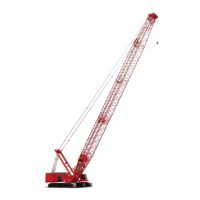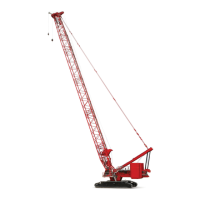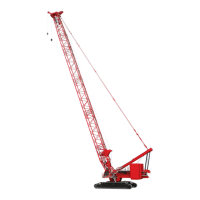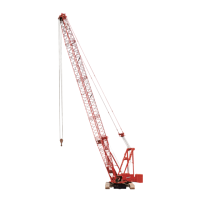Manitowoc Published 11-22-17, Control # 257-02 8-7
MLC300 SERVICE/MAINTENANCE MANUAL UNDERCARRIAGE
TRAVEL MOTOR CASE FLUSHING
See Figure 8-3 for the following descriptions.
The purpose of the travel motor case flushing circuit is to
provide a continuous flow of cool, filtered make-up oil to the
case of both travel motors.
When the engine is running, pump 8 (3) supplies hydraulic
fluid to the inlet port (P1) of the valve manifold (1).
The hydraulic fluid is routed to the inlet port of the relief valve
(2) and to the pressure-reducing valve (4).
The relief valve (2) limits system pressure in the brake and
pawl circuits to 15,2 bar (220 psi).
The pressure-reducing valve (4) reduces pressure in the
flushing circuit to 13 bar (289 psi).
The hydraulic fluid exits from the outlet port (CF) of the valve
manifold, then flows through the swivel (5), and enters the
inlet of the flow divider (6) in the carbody.
The flow divider divides the hydraulic flow 50/50 and directs
the hydraulic fluid to the inlet port (T2) of each travel motor (9
and 10).
The hydraulic fluid exits the outlet port (T1) of each motor
and returns to the tank to continue the cycle of filtering and
cooling the hydraulic fluid to the travel motor cases.
Accumulators (8 and 11) protect the motor cases from
damage during storage or shipping by absorbing pressure
increases caused by thermal expansion. This protection is
needed because the hydraulic fluid is trapped in the motors
by quick disconnects on the hoses.

